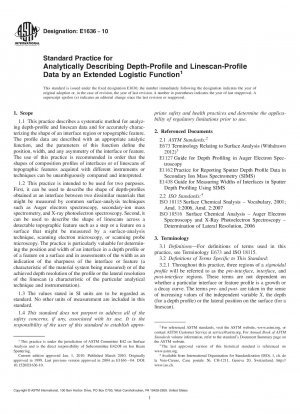ASTM E1636-10
Standard Practice for Analytically Describing Depth-Profile and Linescan-Profile Data by an Extended Logistic Function
- Standard No.
- ASTM E1636-10
- Release Date
- 2010
- Published By
- American Society for Testing and Materials (ASTM)
- Latest
- ASTM E1636-10
- Scope
Information on interface composition is frequently obtained by measuring surface composition while the specimen material is gradually removed by ion bombardment (see Guide E1127 and Practice E1162). In this way, interfaces are revealed and characterized by the measurement of composition versus depth to obtain a sputter-depth profile. The shape of such interface profiles contains information about the physical and chemical properties of the interface region. In order to accurately and unambiguously describe this interface region and to determine its width (see Guide E1438), it is helpful to define the shape of the entire interface profile with a single analytic function.
Interfaces in depth profiles from one semi-infinite medium to another generally have a sigmoidal shape characteristic of the cumulative logistic distribution. Use of such a logistic function is physically appropriate and is superior to other functions (for example, polynomials) that have heretofore been used for interface-profile analysis in that it contains the minimum number of parameters for describing interface shapes.
Measurements of variations in signal intensity or surface composition as a function of position on a surface give information on the shape of a step or topographic feature on a surface or on the sharpness of an interface at a phase boundary. The shapes of steps or other features on a surface can give information on the lateral resolution of a surface-analysis technique if the sample being measured has sufficiently sharp edges (see ISO 18516). Similarly, the shapes of compositional variations across a surface can give information on the physical and chemical properties of the interface region (for example, the extent of mixing or diffusion across the interface). It is convenient in these applications to describe the measured linescan profile with an appropriate analytic function.
Although the logistic distribution is not the only function that could be used to describe measured linescans, it is physically plausible and it has the minimum number of parameters for describing such linescans.
Many attempts have been made to characterize interface profiles with general functions (such as polynomials or error functions) but these have suffered from instabilities and an inability to handle poorly structured data. Choice of the logistic function along with a specifically written least-squares procedure (described in Appendix X1) can provide statistically evaluated parameters that describe the width, asymmetry, and depth of interface profiles or linescans in a reproducible and unambiguous way.
1.1 This practice describes a systematic method for analyzing depth-profile and linescan data and for accurately characterizing the shape of an interface region or topographic feature. The profile data are described with an appropriate analytic function, and the parameters of this function define the position, width, and any asymmetry of the interface or feature. The use of this practice is recommended in order that the shapes of composition profiles of interfaces or of linescans of topographic features acquired with different instruments or techniques can be unambiguously compared and interpreted.
1.2 This practice is intended to be used for two purposes. First, it can be used to describe the shape of depth-profiles obtained at an interface between two dissimilar materials that might be measured by common surface-analysis techniques such as Auger electron spectroscopy, secondary-ion mass spectrometry, and X-ray photoelectron spectroscopy. Second, it can be used to describe th......
ASTM E1636-10 Referenced Document
- ASTM E1127 Standard Guide for Depth Profiling in Auger Electron Spectroscopy
- ASTM E1162 Standard Practice for Reporting Sputter Depth Profile Data in Secondary Ion Mass Spectrometry (SIMS)
- ASTM E1438 Standard Guide for Measuring Widths of Interfaces in Sputter Depth Profiling Using SIMS
- ASTM E673 Standard Terminology Relating to Surface Analysis
- ISO 18115 Surface chemical analysis - Vocabulary; Amndment 2
- ISO 18516 Surface chemical analysis — Determination of lateral resolution and sharpness in beam based methods with a range from nanometres to micrometres
ASTM E1636-10 history
- 2010 ASTM E1636-10 Standard Practice for Analytically Describing Depth-Profile and Linescan-Profile Data by an Extended Logistic Function
- 2004 ASTM E1636-04 Standard Practice for Analytically Describing Sputter-Depth-Profile Interface Data by an Extended Logistic Function
- 1994 ASTM E1636-94(1999) Standard Practice for Analytically Describing Sputter-Depth-Profile Interface Data by an Extended Logistic Function
